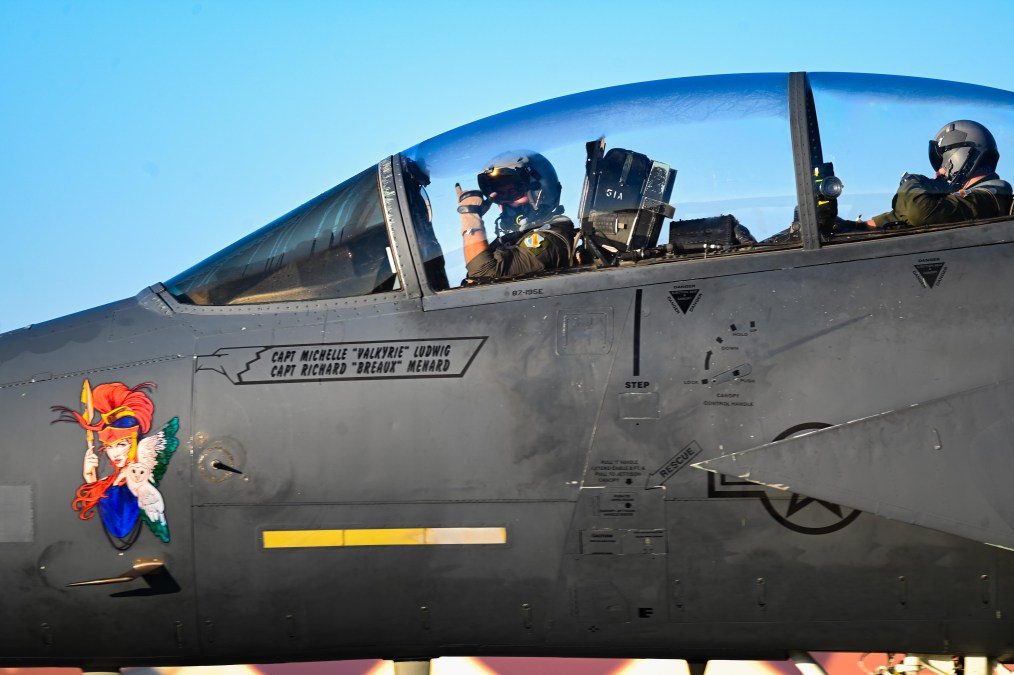Air Force looking for more realistic EW training

The Air Force’s Spectrum Warfare Wing wants to introduce more realistic electromagnetic spectrum training to better prepare airmen for the dynamic, contested and congested fight the military anticipates against sophisticated adversaries in the future.
To do so, the air service is looking to adopt live, virtual and constructive training, which allows the military to be able to insert replicated and simulated capabilities in live training environments for a more realistic feel for warfighters.
Enhancing LVC has been a big push in the non-kinetic realm, especially electronic warfare, given the jamming signals require lengthy coordination with domestic agencies to prevent disruption to civilian services such as comminutions or even airplanes and the desire for adversaries not to collect on some of these advanced waveforms to develop countermeasures against them.
“In the live construct, I will tell you, it’s difficult. I mean, we have adversaries that are out there taking a look at us when we’re operating live. They want to collect on us so that they have their own databases to basically counter us when we actually get into a kinetic fight,” Col. Larry Fenner, commander of the 350th Spectrum Warfare Wing, said at the Mitchell Institute Airpower Futures Forum on Wednesday.
Created in 2021, the 350th has three main areas of focus: rapid reprogramming; target and waveform development; and assessment of Air Force EW capabilities.
Adversaries such as Russia and China have keenly observed U.S. military bases and exercises to be able to collect certain signals. Russia has sought to monitor exercises in Europe while China has set up surveillance outposts as close to the U.S. mainland as Cuba, meant to hoover up valuable digital intelligence.
To shield from this, Fenner wants more augmented reality capabilities to train with.
“How do you train in the cockpit and provide that warfighter the training that they need? That’s going to be difficult because the more you build up your ranges, you can put overhead and things like that to collect on these particular ranges,” Fenner said. “For me and my team, we’re taking a look at augmented reality. How do I insert that particular combat scenario into that cockpit without leaking out what information I’m actually training against or I have the information radiating out of my aircraft so my adversary never can collect on it, but we get quality training for our warfighters to operate in that environment for the virtual construct, for the joint simulation environment?”
The newly established 950th Spectrum Warfare Group, which officially stood up at the end of October and is focused on combat electronic warfare assessments, will be taking this challenge head-on.
“We just set up the 950th Spectrum Warfare Group and that is the group that is going to specifically get after our EW assessments, whether it’s in the live, the virtual or the modeling and sim constructs, that’s where we’re going to make an aggressive push to identify where those gaps and seams are, whether it’s in our training, whether it’s in our capabilities, whether it’s in our tactics, techniques and procedures, and highlight those so we can report those up to higher echelon,” Fenner said. “I have pushed for the 950th Spectrum Warfare Group … to go take a look at the JSC and see where we can introduce better capabilities to get a better, I would say the truth data, on how well our systems are operating within that environment. Because if we’re not truly training like we fight because we’re not turning systems on, we’re not training against specific threats, then are we truly prepared for that pacing challenge threat.”
Fenner noted the Air Force is also looking at enhancing modeling and simulation capabilities to improve the fidelity of training.
“Gone are days where we take a system and we put a couple of testers on it and we introduce it one vs. one against a threat. That’s not how we’re going to fight and that is not the environment that that system is going to operate in and provide defensive capabilities or offensive capabilities for that warfighter,” he explained. “It has to be a many-on-many dynamic capability that has truthful red data from the intelligence community to make sure that that system is radiated and then true blue data in that system so that we’re not missing things because of classification levels and things like that. We have a true representation of what that system is going to do in that warfighting scenario and get the truth done.”
Industry is excited about the push to improve training, particularly with more modeling and simulation and LVC.
“Now we have the ability to go faster because we have the modeling and simulation capability to do it and we want to help with that. We also have the ability to do it at a lower cost because we can now run it through a lot more modeling and sim before we start going through live fly and live development,” Chris Moeller, head of Air and Space Force customer requirements at BAE Systems, said at the same event. “This is something that’s been missing for a very long time and has driven to higher costs and I would say, less trust by the warfighter in their electronic warfighting systems. EW is add-on in your tactics and techniques, to where you go ‘I’ll also run some EW, but I’m going to run my tactic based off ranges and the weapons I have because I don’t know if it’s actually going to be working.’ If we can build that trust in the virtual construct, in the virtual environment, then suddenly these systems become something that is not just an add-on, but is driving our tactics, techniques because our warfighters can rely on it.”






